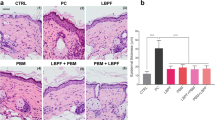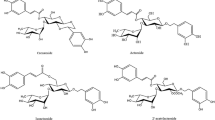Abstract
Bupleurum scorzonerifolium Willd has been found to have a wide range of immunopharmacologic functions. We isolated an anti-UVB B. scorzonerifolium cell clone and found elevated level of polysaccharides. In this study, we investigated the ability of crude polysaccharide (CP) from the anti-UVB B. scorzonerifolium cell clone to inhibit UVB-induced photodamage using a human skin keratinocyte cell line, HaCaT. Cells were UVB irradiated and then incubated in presence of different concentrations of CP. MTT assay showed that the CP did not induce cytotoxic effect under 10 mg/mL and after UVB irradiation, CP can inhibit UVB-induced HaCaT cell death. Decreased reactive oxygen species and lipid peroxidation and increased superoxide dismutase activity showed that CP can act as a free radical scavenger. Furthermore, CP had a strong protective ability against UVB-induced DNA damage. These effects were compared to the crude polysaccharide (CP′) from normal B. scorzonerifolium callus at concentration of 20 mg/mL. The portion of crude polysaccharide (CP) from the anti-UVB B. scorzonerifolium cell clone was more than 2.5-fold higher than crude polysaccharide (CP′) from normal B. scorzonerifolium callus. Taken together, the protective mechanisms of crude polysaccharide from the anti-UVB B. scorzonerifolium cell clone against UVB-induced photodamage occur by the inhibition of UVB-induced reactive oxygen species production, lipid peroxidation and DNA damage.






Similar content being viewed by others
Abbreviations
- 2,4-D:
-
2,4-dichlorophenoxyaceic acid
- CM-DCF:
-
Chloromethyl 2′,7′-dichlorodihydrofluorescein diacetate
- CM-H2DCFDA:
-
5-(and-6)-chloromethyl-2′,7′-dichlorodihydrofluorescein diacetate acetyl ester
- CP:
-
Crude polysaccharides from anti-UVB B. scorzonerifolium cell clone
- CP′:
-
Crude polysaccharides from normal callus of B. scorzonerifolium
- CP*:
-
Crude polysaccharides from the aerial parts of Wild B. scorzonerifolium
- DMEM:
-
Dulbecco’s modified Eagle medium
- DMSO:
-
Dimethylsulfoxide
- FCS:
-
Fetal calf serum
- MDA:
-
Malondialdehyde
- MTT:
-
3-(4,5-dimethylthiazol-2-yl)-2,5-diphenyltetrazolium bromide
- ROS:
-
Reactive oxygen species
- SOD:
-
Superoxide dismutase
- UVB:
-
Ultraviolet-B
References
Bartosz G (2006) Use of spectroscopic probes for detection of reactive oxygen species. Clin Chim Acta 368:53–76
Bermejo P, Abad MJ, Diaz AM, Fernandez L, De Santos J, Sanchez S, Villaescusa L, Carrasco L, Irurzun A (2002) Antiviral activity of seven iridoids, three saikosaponins and one phenylpropanoid glycoside extracted from Bupleurum rigidum and Scrophularia scorodonia. Planta Med 68:106–110
Besaratinia A, Synold TW, Chen HH, Chang C, Xi B, Riggs AD, Pfeifer GP (2005) DNA lesions induced by UV A1 and B radiation in human cells: comparative analyses in the overall genome and in the p53 tumor suppressor gene. Proc Natl Acad Sci USA 102:10058–10063
Buysse JAN, Merckx R (1993) An improved colorimetric method to quantify sugar content of plant tissue. J Exp Bot 44:1627–1629
Chang WL, Chiu LW, Lai JH, Lin HC (2003) Immunosuppressive flavones and lignans from Bupleurum scorzonerifolium. Phytochemistry 64:1375–1379
Chinese Pharmacopoeia Commission (2005) Pharmacopoeia of people’s republic of China, vol 1. English Edition. Chemical Industry Press, Beijing
de Gruijl FR (2002) Photocarcinogenesis: UVA versus UVB radiation. Skin Pharmacol Appl Skin Physiol 15:316–320
Fubini B, Hubbard A (2003) Reactive oxygen species (ROS) and reactive nitrogen species (RNS) generation by silica in inflammation and fibrosis. Free Radic Biol Med 34:1507–1516
Granstein R, Matsui M (2004) UV radiation-induced immunosuppression and skin cancer. Cutis 74:4–9
Halliday GM (2005) Inflammation, gene mutation and photoimmunosuppression in response to UVR-induced oxidative damage contributes to photocarcinogenesis. Mutat Res 571:107–120
Huang JH, Huang CC, Fang JY, Yang C, Chan CM, Wu NL, Kang SW, Hung CF (2010) Protective effects of myricetin against ultraviolet-B-induced damage in human keratinocytes. Toxicol In Vitro 24:21–28
Ichihashi M, Ueda M, Budiyanto A, Bito MO T, Fukunaga M, Tsuru K, Horikawa T (2003) UV-induced skin damage. Toxicology 189:21–39
Kulms D, Schwarz T (2002) Independent contribution of three different pathways to ultraviolet-B-induced apoptosis. Biochem Pharmacol 64:837–841
Li XT, Chen R, Jin LM, Chen HY (2009) Regulation on energy metabolism and protection on mitochondria of Panax ginseng polysaccharide. Am J Chin Med 37:1139–1152
Li Y, Fan J, Ma H, Shen F, Zhang G, Wang J, Xia G, Fan D, Chen S (2011) Elevated level of polysaccharides in a high level UV-B tolerant cell line of Bupleurum scorzonerifolium Willd. Afr J Biotechnol 10:5578–5586
Liao YH, Jones SA, Forbes B, Martin GP, Brown MB (2005) Hyaluronan: pharmaceutical characterization and drug delivery. Drug Deliv 12:327–342
Marrot L, Meunier JR (2008) Skin DNA photodamage and its biological consequences. J Am Acad Dermatol 58:S139–S148
Matsumura Y, Ananthaswamy HN (2004) Toxic effects of ultraviolet radiation on the skin. Toxicol Appl Pharmacol 195:298–308
Mosmann T (1983) Rapid colorimetric assay for cellular growth and survival: application to proliferation and cytotoxicity assays. J Immunol Methods 65:55–63
Murashige T, Skoog F (1962) A revised medium for rapid growth and bioassays with tobacco tissue culture. Physiol Plant 15:473–497
Nishigori C, Hattori Y, Toyokuni S (2004) Role of reactive oxygen species in skin carcinogenesis. Antioxid Redox Signal 6:561–570
Portugal M, Barak V, Ginsburg I, Kohen R (2007) Interplay among oxidants, antioxidants, and cytokines in skin disorders: present status and future considerations. Biomed Pharmacother 61:412–422
Shindo Y, Witt E, Packer L (1993) Antioxidant defense mechanisms in murine epidermis and dermis and their responses to ultraviolet light. J Investig dermatol 100:260–265
Sies H, Stahl W (2004) Nutritional protection against skin damage from sunlight. Annu Rev Nutr 24:173–200
Singla AK, Chawla M (2001) Chitosan: some pharmaceutical and biological aspects–an update. J Pharm Pharmacol 53:1047–1067
Sinha RP, Häder D-P (2002) UV-induced DNA damage and repair: a review. Photochem Photobiol Sci 1:225–236
Sun L, Feng K, Jiang R, Chen J, Zhao Y, Ma R, Tong H (2010) Water-soluble polysaccharide from Bupleurum chinense DC: isolation, structural features and antioxidant activity. Carbohydr Polym 79:180–183
Svobodová A, Psotová J, Walterová D (2003) Natural phenolics in the prevention of UV-induced skin damage. A review. Biomed Pap Med Fac Univ Palacky Olomouc Czech Repub 147:137–145
Svobodová A, Walterova D, Vostalova J (2006) Ultraviolet light induced alteration to the skin. Biomed Pap Med Fac Univ Palacky Olomouc Czech Repub 150:25–38
Tomida H, Fujii T, Furutani N, Michihara A, Yasufuku T, Akasaki K, Maruyama T, Otagiri M, Gebicki JM, Anraku M (2009) Antioxidant properties of some different molecular weight chitosans. Carbohydr Res 344:1690–1696
Van Laethem A, Garmyn M, Agostinis P (2009) Starting and propagating apoptotic signals in UVB irradiated keratinocytes. Photochem Photobiol Sci 8:299–308
Acknowledgments
This work was supported by the National Natural Science Foundation of China (30760089).
Author information
Authors and Affiliations
Corresponding author
Additional information
Jinran Dai and Haiyin Ma authors contribute equally to this article.
Rights and permissions
About this article
Cite this article
Dai, J., Ma, H., Fan, J. et al. Crude polysaccharide from an anti-UVB cell clone of Bupleurum scorzonerifolium protect HaCaT cells against UVB-induced oxidative stress. Cytotechnology 63, 599–607 (2011). https://doi.org/10.1007/s10616-011-9381-6
Received:
Accepted:
Published:
Issue Date:
DOI: https://doi.org/10.1007/s10616-011-9381-6




